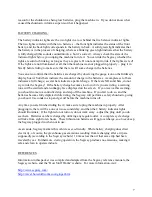
EDUCATIONAL GOALS
The purpose when demonstrating the Segway i2 for visitors is the same as for the older model:
compare how the human body balances and moves with how this machine does it. As the
Segway literature explains:
“If you stand up and lean forward so that you are out of balance, you probably won't fall on your
face. Your brain knows you are out of balance, because fluid in your inner ear shifts, so it
triggers you to put your leg forward and stop the fall. If you keep leaning forward, your brain
will keep putting your legs forward to keep you upright. Instead of falling, you walk forward,
one step at a time.
The Segway PT does pretty much the same thing, except it has wheels instead of legs, a motor
instead of muscles, a collection of microprocessors instead of a brain, and a set of sophisticated
tilt sensors and gyroscopic sensors instead of an inner-ear balancing system. Like your brain, the
Segway PT knows when you are leaning forward. To maintain balance, it turns the wheels at just
the right speed, so you move forward. Segway calls this behavior
dynamic stabilization
and
has patented the unique process that allows the Segway PT to balance on just two wheels.”
When the older Segway is repaired, you will also have a chance to compare the two different
models out on the floor.
The Segways should only be demonstrated in the Atrium and Franklin Gallery (a.k.a. Key
Hallway).
HOW IT WORKS
The Segway is run by a network of sensors, mechanical assemblies, electronic controls, and a
motor system. The primary sensors
are a series of gyroscopes. However, these are
not
in the
form of a traditional gyroscope (i.e., a spinning wheel mounted within a stable frame). Rather,
they are solid-state angular rate sensors, with no moving mechanical parts. They each consist of
a tiny silicon plate mounted on a support frame. An electrostatic current is applied across the
plate, causing the silicon particles to move. The particles move in a particular way, which makes
the plate vibrate in a predictable manner. When the plate is rotated around its axis (that is, when
the Segway turns in that particular plane), the particles suddenly shift in relation to the plate.
This alters the vibration, and that alteration is proportional to the degree of rotation. The
gyroscope system measures the change in vibration and passes this information on to the
Segway’s computer brain, which can then determine when and how quickly the machine is
rotating along particular axes, and what needs to be done to remain upright. To clarify: the
gyroscopes are strictly sensors, used to
detect
motion changes. They do not actually exert any
force on the Segway to help it stay balanced.
The Segway has a total of five gyroscopic sensors, all operating simultaneously. However, it
only
needs
three to function: one to detect
pitch
(leaning forward and backward), one to sense
roll
(leaning to the left or right), and the third to identify
yaw
(steering to the left or right). The
2


























